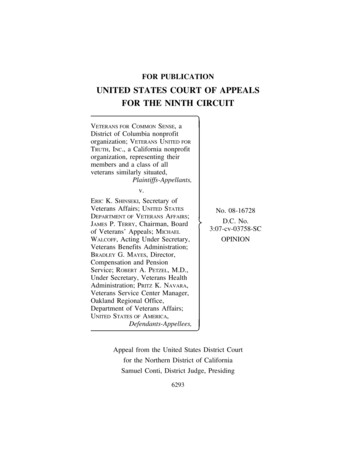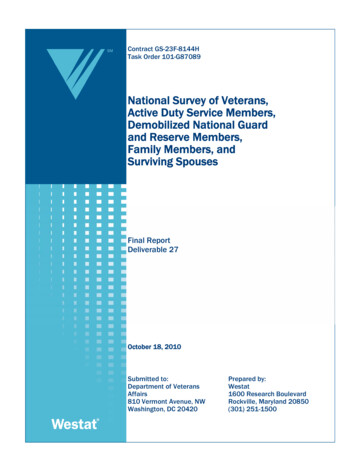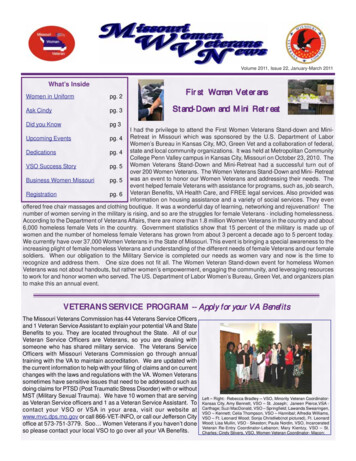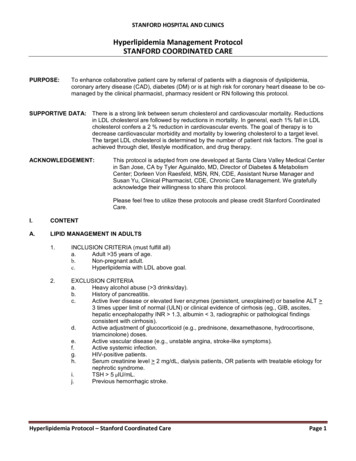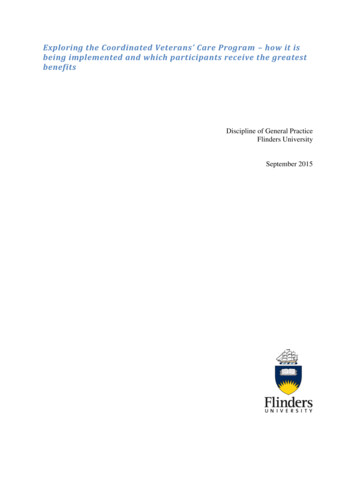
Transcription
Exploring the Coordinated Veterans’ Care Program – how it isbeing implemented and which participants receive the greatestbenefitsDiscipline of General PracticeFlinders UniversitySeptember 2015
Executive SummaryOverview of the Coordinated Veterans’ Care ProgramThe Department of Veterans’ Affairs (DVA) Coordinated Veterans’ Care (CVC) Program isa team-based program designed to improve care and reduce unplanned hospital admissionsand re-admissions through a coordinated model of care. The program is aimed at those GoldCard holders with chronic conditions, and complex care needs who are most at risk ofunplanned hospitalisation.The underlying premise behind chronic disease care coordination programs is that peoplewith chronic diseases have significantly poorer outcomes and higher health care costs thanshould be achievable if they received evidence based and coordinated care and they adheredto medication, exercise, diet and self-care regimes.As at 30 June 2015, there had been approximately 29,700 Gold Card holders enrolled in theCVC Program since its introduction in May 2011. The program targets five conditions whereimproved coordinated community care has the potential to reduce unplanned hospitalisation.These are: congestive heart failurecoronary artery diseasepneumoniachronic obstructive pulmonary diseasediabetes.General Practitioners (GPs) are paid to enrol Gold Card holders onto the CVC Program andto provide ongoing, comprehensive and coordinated care with the assistance of their practicenurse or a community nurse (from a DVA contracted provider).The scope and aims of the present researchThe general aim of the present research project was to explore how the CVC program wasbeing implemented in general practice and identify which participants were receiving thegreatest benefits. Specifically the project aimed to: Perform a comprehensive literature review of primary care interventions that havesought to reduce health care costs and synthesise this literature to identify thecritical elements for success for care coordination programs; and Conduct qualitative interviews with a sample of general practices to examine thedegree to which care coordination elements for success (identified in the literaturereview) are present in the CVC Program. Integrate the findings from the literature review and the qualitative interviews toprovide a summary of the key implications of the present research for DVA.
Literature review of care coordination programs to identify critical elements for successA comprehensive literature review was performed to examine the evidence base for primarycare interventions that improve the management of chronic disease, with a specific focus onthe impact of interventions that reduce unnecessary health service use in older patients withchronic disease. In addition, an in-depth case study approach was used to examine a numberof care coordination programs, which have been implemented in Australia and US.Based on an initial review of the literature and in-depth case studies in the context of theAustralian health care system, effective care coordination and disease management programswill be characterised by the following: High levels of in-person contact between care coordinators and patients; High levels of collaboration between care coordinators and general practitioners; Careful targeting to patients who are both likely to benefit from care coordinationand have high costs that can be moderated; A strong emphasis on medication adherence; Thorough assessments and care planning; Support for patient education and self-management; Close attention to transitions between primary and secondary care; and A quality improvement approach for program development and refinement.Qualitative interviews with general practicesQualitative interviews were conducted with a sample of 20 general practices to examine thedegree to which care coordination elements for success (identified in the literature review)were present in the CVC Program. A purposive sampling technique was used, based on thetype of community served (regional and urban communities) and numbers of CVC patients.Practices were selected from former Medicare Local regions in South Australia and fromregional and urban Queensland regions (Metro North and South Brisbane, Gold Coast,Sunshine Coast, West Morton-Oxley and Wide Bay). The results from the interviews arepresented around the key characteristics for successful care coordination programs identifiedin the literature review.Targeting correct patients. Patients were most often invited to enrol in the CVC Programwhere GPs (and care coordinators) believed that the patient would benefit from the programand that they were at risk of poor health outcomes. There was considerable variabilitybetween practices with respect to how practices identified which patients would benefit fromthe program or how “risk” of poor health outcomes was assessed.In-person interaction between care coordinators and patients. Effective carecoordination programs are characterised by high levels of in-person contact between carecoordinators and patients. From the interviews it appeared that the majority of contactbetween care coordinators and patients occurred by telephone and not in-person.GP engagement and teamwork. GPs needed to be effectively involved and to collaboratewith care coordinators for the delivery of care coordination to be successful. Intervieweesreported effective communication between care coordinators and GPs. Information regardingpatient care was shared via electronic systems (e.g. in notes associated with patient files), via
impromptu meetings or via scheduled appointments with CVC patients. In general, practicenurses were comfortable approaching GPs as required and often worked together tocoordinate care for a patient. Regular practice meetings provided a further opportunity forcommunication.Medications. There is good evidence that poor management and coordination of medicationscontributes significantly to increased health costs and hospital admission rates. Medicationmanagement was identified as an important part of the CVC Program by the majority ofinterviewees. Coordinating care with a pharmacist who conducts home medicine reviews wasone of the most common ways that practices sought to improve medication management.Transitional care. Transitional care interventions are designed to facilitate smoother, safer,and more efficient transitions from hospital to primary care. In the CVC Program, carecoordinators are expected to liaise with hospital staff upon learning of an unplannedadmission and request discharge information, or be involved in the discharge planningprocess if appropriate. For the most part there was very little evidence that improvedtransitional care was being implemented in the CVC Program.Evidence based patient education interventions. There is growing research evidence thatpatient education and self-management support can improve symptoms of some chronicillnesses. From the interviews it is clear that CVC care coordinators provide self-managementsupport in a relatively unstructured manner and that many care coordinators have receivedvery little formal self-management training.GP and care coordinators’ perceptions of CVC Program benefits. GPs and carecoordinators believed that hospitalisations were being prevented because of the CVCProgram. This was attributed to early intervention, regular contact with patients, mentalhealth support, care coordination, increased medication compliance and falls prevention. Itwas believed that information gathered by care coordinators, particularly during home visitsand monthly phone calls, differed from the information available to GPs following standardconsultations. This information improved the capacity of the practice to provide holistic careand was highly valued.Implications of the findings of this research for DVAIn discussing the implications of this research for DVA it is important to recognise a numberof key contextual factors. These are: It is widely recognised in Australia and internationally, that the increasing demandsplaced on health care systems from aging populations with chronic health needsrequires better care coordination. The DVA CVC Program is a significant care coordination program by Australianand international standards. The model adopted in the CVC Program comprisesmany of the critical elements for success identified in the research literature. Developing cost-effective programs to achieve better care coordination takesexperimentation, evaluation and refinement over a period of years. It is onlyrelatively recently that the critical elements for effective programs have beenidentified.
The present research has found that the CVC Program comprises two key strengths that havebeen recognised in the literature as being crucial to the success of care coordinationprograms: the design of the CVC Program promotes collaborative teamwork between carecoordinators and GPs, and the CVC Program model encourages GP involvement and engagement in healthassessment and care planning which is crucial if the delivery of care coordination isto be successful.The presence of these crucial design elements is illustrated by the rapid uptake by olderveterans on the program and the broad acceptance of the program in general practice. Theresults from the present research do however suggest that there are a number ofimprovements that could be made to the CVC Program to improve its operation.Better patient targetingThe majority of patients enrolled in the CVC Program have been done so on the basis of a GPassessment of likelihood of benefit. Currently this assessment is subjective, unstructured andit appears that there is variation in how GPs are selecting patients for enrollment into theCVC Program. DVA should consider developing a more structured and standardisedapproach for GPs to use to identify appropriate candidates to the CVC Program.More detailed specification of the process of care coordinationDVA should consider providing a more detailed specification of the process of carecoordination to GPs and care coordinators. The desire for practical resources that are moreprocess driven and that detail the CVC Program requirements was expressed by both GPs andcare coordinators. This more detailed specification would focus particularly on transitionalcare planning, patient self management support and medication management. ImportantlyDVA should also consider increasing the amount of in-person interaction between patientsand care coordinators required under the CVC Program.More face to face training opportunities for care coordinatorsFurther training and support to care coordinators is required if the CVC Program is to beconsistently implemented to a high standard; including training in a more detailedspecification of care coordination activities. Optimally, this will include face to face trainingas care coordinators express a strong preference for this type of training because it allows theopportunity to ask questions and network with others.Assist GPs to improve medication managementA substantial amount of effort around medication management is taking place especiallyregarding monitoring adherence and home medications reviews. DVA could considerproviding more timely and higher quality information about medications to GPs. The firststep however is to better use the information that is already available. This would includeimproving GP knowledge and access to the Patient Treatment Report (PTR) and makinggeneral practices aware they can choose the method of delivery (paper versions, HealthProfessional Online Services portal or via secure electronic messaging).
Quality improvement programA quality improvement approach for program development and refinement was identified inthe literature review as a key element of effective care coordination and disease managementprograms. Regular review of CVC patients both with regard to the care being received as wellas adherence to the CVC program guidelines has the potential to improve the careparticipants in the CVC program. There are numerous quality improvement models that canbe implemented at all levels of the primary health care system, including the federal, state,Primary Health Network and practice level. DVA should consider developing a CVCProgram specific quality improvement program.Further researchThere are a number of opportunities for further research to contribute to the continuingdevelopment of the CVC Program. Two future research projects could be considered byDVA. Develop and pilot test an enhanced model of CVC care using the results from thepresent project. The purpose of this pilot study is to determine whether the changesoutlined in the present study are feasible to implement in general practices and lead tobetter outcomes for CVC program participants. Develop and test an improved care transitions package for the CVC Program basedaround the electronic systems that have been implemented in some Australian healthregions to improve information flows between major hospitals in the region andprimary care.ConclusionThere is an important need to develop cost effective primary care based care coordinationprograms for older Australians (both veterans and non-veterans) living with chronic diseases.The CVC Program is highly innovative in how it provides better services to meet the healthneeds of veterans with chronic diseases. This research has identified that improvements canbe made to the CVC Program which will contribute to better health outcomes for veteransincluding reducing the need for hospitalisations and, potentially, health care savings.
with chronic diseases have significantly poorer outcomes and higher health care costs than should be achievable if they received evidence based and coordinated care and they adhered to medication, exercise, diet and self-care regimes. As at 30 June 2015, there had been approximately 29,700 Gold Card holders enrolled in the




